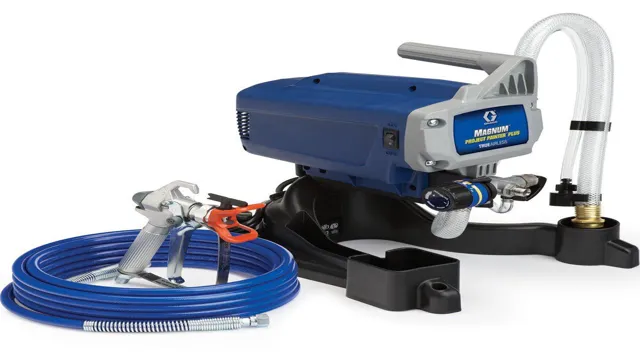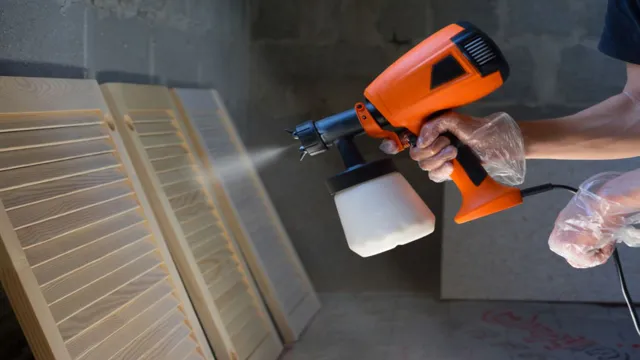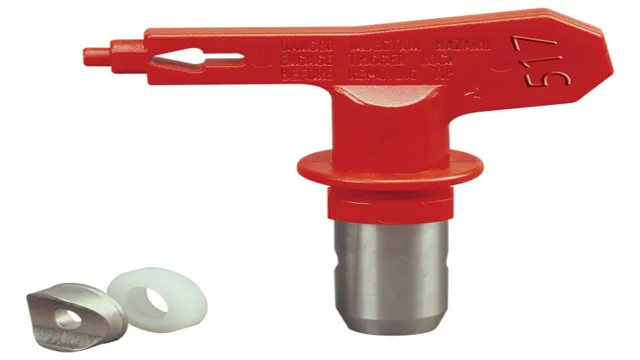Can a Paint Sprayer Be Used for Stain? Find Out the Pros and Cons.
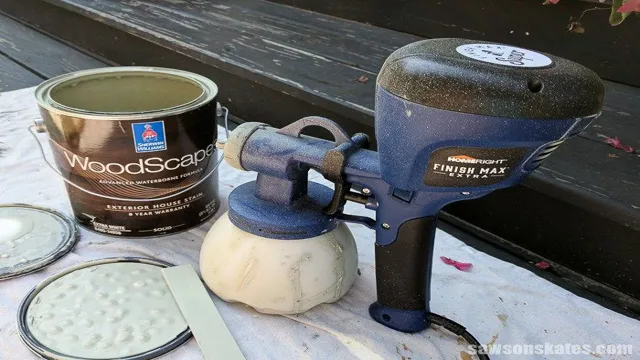
Painting is an excellent way to transform a space, but the task of staining a large area can be overwhelming. A paint sprayer, however, is a useful tool that can make the job go smoothly and quickly – or so we’re told. Before you take the plunge into the world of paint sprayers, it’s essential to understand their pros and cons in staining.
While some swear by them, others have found out that they aren’t a one-size-fits-all solution. So, what are the advantages of using a paint sprayer for staining? For starters, a sprayer can cover large surfaces in a matter of seconds, saving you time and energy. They are also easy to use, even for beginners, and offer a uniform and flawless finish.
Moreover, they allow you to reach tight spaces that might otherwise be inaccessible, producing a professional-looking finish. Despite its benefits, using a paint sprayer for staining also has its downsides. For one, sprayers tend to produce a lot of overspray, which can be hard to control.
This can lead to a mess and requires a lot of prep work, so covering furniture, floors, and surroundings will be necessary. Additionally, sprayers require a lot of cleaning and maintenance, which may increase the overall cost significantly. Lastly, sprayers can be noisy and require a constant power supply, making them less convenient than traditional brushes or rollers.
In conclusion, paint sprayers can be a game-changer in staining if used correctly. While they have their benefits, it’s important to consider the downsides before investing in one. If you’re on the fence, it may be worth it to consult with a professional or conduct thorough research before making a decision.
Understanding Paint Sprayers and Stains
Yes, a paint sprayer can be used for applying stain, but there are a few things to keep in mind when doing so. First, make sure that the sprayer is compatible with stain and has the necessary nozzle size for the job. Stain is typically thinner than paint, so a smaller nozzle size may be needed to provide a more consistent application.
Additionally, it’s important to thin the stain to the proper consistency so that it can be sprayed effectively. In general, a 10% to 15% thinning ratio is recommended. Finally, be sure to wear protective gear and take precautions to minimize overspray, as stain can be messy and difficult to clean up.
Overall, using a paint sprayer for stain can be a great way to achieve a smooth, even finish with less effort than traditional methods.
Types of Paint Sprayers and Stains
When it comes to painting, there are different tools and techniques that can be used, but paint sprayers and stains are some of the most popular ones. Paint sprayers come in three main types: airless, air-assisted airless, and HVLP. Airless sprayers are great for large projects because they can spray thick coatings quickly and efficiently.
Air-assisted airless sprayers use compressed air to atomize the paint, providing a smoother finish. HVLP (High Volume Low Pressure) sprayers are ideal for fine finishes on smaller projects. Stains, on the other hand, are used to enhance the natural beauty of wood and protect it from wear and tear.
There are two main types of stains: water-based and oil-based. Water-based stains dry faster and have less odor, while oil-based stains provide a richer color and better grain penetration. Knowing the differences between the types of sprayers and stains can help you choose the right one for your project and achieve great results.
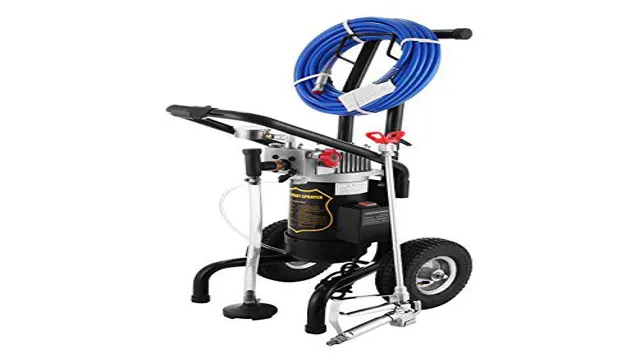
Comparing the Application Process
When it comes to home improvement projects, using a paint sprayer or stain can save time and provide a professional finish. However, understanding the application process is key to achieving the desired results. Paint sprayers use high-pressure air to atomize paint, while stains are thin enough to be applied with a brush or roller.
It’s important to choose the right sprayer or tool for the job, as well as proper prep work such as masking and covering surfaces to protect from overspray or drips. When it comes to stains, the type of wood and previous finishes can impact the final outcome, so it’s important to properly clean and sand surfaces before application. Whether using a paint sprayer or stain, taking the time to properly prepare and understand the application process can lead to a successful home renovation project.
The Advantages of Using a Paint Sprayer for Staining
Yes, a paint sprayer can certainly be used for stain. In fact, using a paint sprayer for staining can make the process faster, more efficient, and produce better results overall. One of the main advantages of using a sprayer for stain is that it allows for an even, consistent coat.
With a brush, it’s easy to miss spots or leave streaks, but a sprayer ensures that the entire surface is covered evenly. Additionally, using a sprayer can save you time and effort. Staining a large surface with a brush can be time-consuming and tiring, but with a sprayer, you can get the job done quickly and with less strain on your arms and back.
Finally, a paint sprayer can also help you save money on stain. It’s easy to waste stain with a brush, but with a sprayer, you can use just the right amount, reducing your overall costs. So if you’re looking for a way to make staining faster, easier, and more efficient, consider using a paint sprayer for your next project.
Efficiency and Speed
If you’re looking to stain a large surface, using a paint sprayer can save you a lot of time and effort compared to traditional methods. One of the main advantages of using a paint sprayer for staining is its efficiency. With a sprayer, you can cover a large surface area quickly and evenly, without leaving any brush marks or streaks.
Plus, you can adjust the spray pattern and flow rate to suit the specific project, ensuring that you get optimal coverage and a smooth finish. Another advantage is speed. Using a sprayer can cut your staining time in half compared to using a brush or roller, making it an ideal choice for large projects or tight deadlines.
Overall, using a paint sprayer for staining offers incredible efficiency and speed, allowing you to complete your project quickly and with professional-looking results.
Uniform Coverage and Appearance
Staining can be a daunting task, and achieving a uniform coverage and appearance can be even more challenging. However, using a paint sprayer for staining can give you a lot of advantages. One of the main benefits of using a paint sprayer is that it can make your project quicker and easier.
You can cover larger areas in a short amount of time, and the sprayer can evenly distribute the stain, making sure that all surfaces receive the same amount of coverage. This uniform coverage can help you achieve a more professional and polished look, especially on large or complex surfaces like decks or fences. Moreover, using a sprayer can help you avoid brush or roller marks, which can be unsightly on stained surfaces.
Ultimately, using a paint sprayer for staining can help you achieve a beautiful and uniform finish, making your project look like it was done by a pro.
Reduced Downtime and Cleanup
Using a paint sprayer for staining provides several advantages, including reduced downtime and cleanup. Unlike traditional staining methods, paint sprayers allow for faster and more efficient application. With a paint sprayer, you can cover more surface area in less time compared to using a brush or roller.
This can save you a significant amount of time, especially when staining large areas. Additionally, paint sprayers can produce a more even coat of stain compared to traditional methods, resulting in less need for touch-ups or reapplication. Another benefit of using a paint sprayer for staining is that it can minimize the mess involved in the staining process.
Unlike brushes and rollers that can leave drips and splatters, paint sprayers can be adjusted to produce a controlled and even spray. This reduces the likelihood of accidentally staining nearby surfaces, which can save you a lot of time and effort in cleaning up afterward. Overall, if you’re looking for a quicker, more efficient, and cleaner way to stain your surfaces, using a paint sprayer is definitely worth considering.
The Limitations of Using a Paint Sprayer for Staining
Many people wonder if a paint sprayer can be used for stain application, and while it is technically possible, it is not always the best option. One major limitation of using a paint sprayer for staining is the potential for overspray. Stain particles are much smaller than paint particles, making them more difficult to control and increasing the likelihood of overspray.
This can result in a messy and uneven finish, and even damage to surrounding surfaces. Additionally, because stain requires thorough penetration into the wood fibers, it is important to apply it evenly and with proper pressure – something that can be difficult to achieve with a paint sprayer. Ultimately, while a paint sprayer can be used for staining in some cases, it is generally not the most effective or efficient method.
It is usually best to stick with traditional staining techniques using brushes or rollers for optimal results.
Price and Maintenance
While paint sprayers have gained popularity in recent years, they might not be the best option for staining your deck or fence due to some limitations. First and foremost, the price can be a major deterrent. Paint sprayers are quite expensive, and many homeowners might not be willing to invest that much money into a tool they might only use occasionally.
Additionally, maintenance can be a hassle. If not taken care of properly, paint sprayers can clog or malfunction, leading to more time and money spent on repairs or replacements. It’s also important to note that stain requires a different type of sprayer than paint, adding to the overall cost and inconvenience.
While using a paint sprayer for staining can achieve a smooth finish, it’s important to weigh the costs and maintenance requirements before making a decision.
Difficulty with Precision and Detail
When it comes to staining your wooden furniture or decks, using a paint sprayer may not be the best solution. While it may seem like an efficient way to get the job done quickly, paint sprayers are not equipped to handle the precision and detail required for staining. The spray pattern may be too wide, causing the stain to end up in places you didn’t intend.
Additionally, it can be challenging to control the intensity of the spray, making it difficult to achieve an even coat of stain. This can lead to blotchiness or unevenness in the final appearance. Instead, consider using a brush or roller to ensure a more controlled and precise application of stain.
Your furniture or deck will thank you for the extra care and attention!
Tips for Successfully Using a Paint Sprayer for Staining
Yes, a paint sprayer can be used for staining, and in fact, it can be a much quicker and more efficient way to apply stain to large surfaces. However, there are some tips you should keep in mind to ensure successful use of a paint sprayer for staining. First, make sure to properly prepare the surface by cleaning it thoroughly and sanding it if necessary.
Next, choose the right tip size for your sprayer and adjust the spray pattern to achieve the desired coverage. It’s also important to stir and strain the stain before pouring it into the sprayer, and to keep the sprayer moving in a consistent direction while spraying. Finally, be sure to practice on a small, inconspicuous area before tackling the main project, and use caution when spraying around edges and corners to avoid over-spraying and dripping.
With these tips in mind, you can achieve a beautiful, even stain finish with your paint sprayer.
Conclusion
In conclusion, it’s not a matter of can you use a paint sprayer for stain, but should you use a paint sprayer for stain. While it may seem like an easy solution, stains require a different viscosity and application method than paint, which could result in uneven and blotchy results. So, if you want to achieve a smooth and even finish with your stain, it’s best to use a specialized stain sprayer.
Don’t be tempted to take shortcuts – unless you want your project to look like a splatter painting!”
FAQs
What is a paint sprayer?
A paint sprayer is a tool that uses compressed air to spray paint onto a surface.
Can a paint sprayer be used for staining?
Yes, a paint sprayer can be used for stain. However, it is important to choose the right tip and setting for the type of stain being used.
What types of stains can be used with a paint sprayer?
Most types of stains, including oil-based and water-based stains, can be used with a paint sprayer.
What is the benefit of using a paint sprayer for staining?
Using a paint sprayer for staining can provide a more even and consistent finish, as compared to other methods like brushing or rolling.
Can a paint sprayer be used for outdoor staining projects?
Yes, a paint sprayer can be used for outdoor staining projects. It is important to use weather-resistant stain and to protect nearby surfaces from overspray.
Do I need any special equipment to use a paint sprayer for staining?
You will need a paint sprayer, appropriate tips and settings for staining, and protective equipment such as goggles and a respirator.
How do I clean my paint sprayer after using it for staining?
After use, flush the sprayer with water or an appropriate cleaning solution according to the manufacturer’s instructions.

